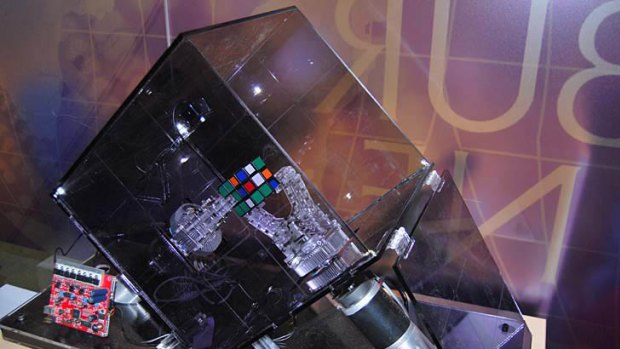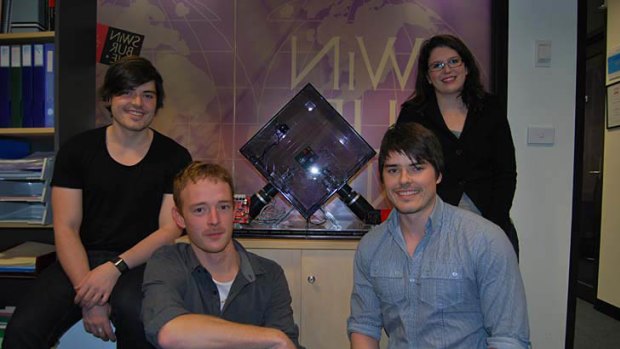This was published 12 years ago
Meet Ruby, the record-breaking robot that solves Rubik's Cube
By Ben Grubb
Australian students have built a robot capable of solving Rubik’s Cube in a world record time of just over 10 seconds.
Named Ruby, the robot can solve a scrambled puzzle in 10.69 seconds, including the time taken to scan the initial status of the cube, Melbourne's Swinburne University of Technology said.
Robot Ruby's effort makes other robots seem as though they take forever to solve cubes but is no match for humans. As at October last year, the world's fastest cube-solving robot, the Cubinator, was able to solve a scrambled Rubik's Cube in 18.2 seconds. Australian Feliks Zemdegs, who currently holds the human world record on a 3×3×3 Rubik's Cube, solved one in 6.24 seconds at the Kubaroo Open 2011 in Melbourne.
Ruby was built from scratch by six students at Swinburne for their final year project. The team comprised identical twin "computer whiz kids" David and Richard Bain, Daniel Purvis, Jarrod Boyes, Miriam Parkinson and Jonathan Goldwasser.

Ruby the robot can solve Rubik's Cube in just over 10 seconds.
Rubik's Cube was chosen to be solved using a robot because it was "iconic" for many who grew up in the 80s and early 90s, according to project manager Parkinson, 24, who said the team wasn't initially intending to break any records. "Even though the craze had worn off by the late 80s every one of us had been given a Rubik's Cube at some point as a kid," she said.
When the team made the robot run faster than normal it would "sometimes rip cubes apart", destroying the cube, she said. "Another thing that can happen if you rotate the cube too quickly is that the robot loses grip on the cube and throws it."
One of the first times when students were running the robot's motor at full speed it "carefully and slowly" did a move and then "threw it across the room" when trying to reposition the cube.
The robot solves the puzzle by scanning each face of a scrambled cube through a web camera, according to professor Chris Pilgrim, deputy dean of the Faculty of Information and Communication Technologies at Swinburne. "It then uses a software algorithm to develop a solution which is fed to the high-speed robot through a real-time embedded control system."

Four of the six team members who made Ruby.
It was a "requirement" for the students' capstone project to create something that had "significant electrical, mechanical and software components", student Parkinson said, which is why the $900 robot was built using money provided by the university.
"We knew we were going to be working on this for a year so we wanted to do something fun that would also give us an opportunity to combine the skills and theoretical knowledge that we had developed during our degree into a single project."
The team originally considered making a robot that played scrabble, she said. But after discussing the idea with supervisors it was decided "too simple a problem" to work on as the hardware to manipulate scrabble pieces was "very basic" and the software could rely entirely on existing programs.
It was then decided to make a Rubik's Cube-solving robot as it would give the team a chance "to implement some computer vision to identify the configuration of the cube, use an algorithm to come up with an optimum solution on a PC and then develop a robot that could accept a series of Rubik's Cube notation (Singmaster notation) commands and translate these into the required movements to manipulate the cube", she said.
"This also allowed us to use our knowledge of control engineering, hardware design and electronics design. It was essentially a project that was just complex enough to utilise the skills that we learned during our degree and just simple enough that we could design and build everything ourselves.
"We were also very aware that the calibre of the projects that Swinburne students had produced in previous years was very good so we wanted to make something that would stand out."
The robot uses Kociemba's algorithm to solve scrambled puzzles. "It's the algorithm which was used to prove God's number ... which is the minimum number of moves required to solve any Rubik's Cube," Parkinson said.
After exams finish, the team will be applying to have the record recognised by Guinness World Records. But in the meantime the team is optimising the robot to make it even faster.
In tests conducted with the robot, the team was able to get the timing down to 8.6 seconds, Parkinson said. "If we actually input the solution then it solves it in 5.9."
Realistically she believed the team would be able to get the timing down to 8 seconds consistently without inputting the solution.
The robot will be on show at Swinburne's Open Day August 21.
This reporter is on Twitter: @bengrubb